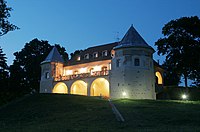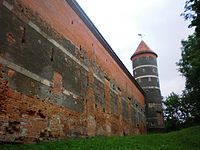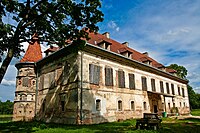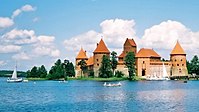
Tukums is a town in the Zemgale region of Latvia.

Baltic German nobility was a privileged social class in the territories of today's Estonia and Latvia. It existed continuously since the Northern Crusades and the medieval foundation of Terra Mariana. Most of the nobility were Baltic Germans, but with the changing political landscape over the centuries, Polish, Swedish and Russian families also became part of the nobility, just as Baltic German families re-settled in locations such as the Swedish and Russian Empires. The nobility of Lithuania is for historical, social and ethnic reasons separated from the German-dominated nobility of Estonia and Latvia.

Bauska Castle is a complex consisting of the ruins of an earlier castle and a later palace on the outskirts of the Latvian city of Bauska.

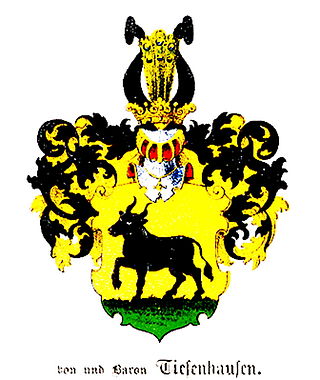
The House of Tiesenhausen is the name of an old Baltic-German noble family. The origins of the family are in Lower Saxony. During the Baltic crusades they settled in Livonia in the first half of the 12th century. Bishops Albert of Riga and Herman of Tartu had a sister whose husband Engelbertus de Tisenhuse was the progenitor of the family in the Baltic. After some time in southern Livonia in the early stages of occupation, Engelbertus joined his brother-in-law bishop Herman to obtain the northern Livonian country of Ugaunia around Otepää and Tartu. It was Ugaunia where the family held its main early properties and positions. Engelbertus' son married a daughter of the castellan of Koknese in Latgale and through this marriage, the family claims descent from indigenous princes of the Latgalians. Some branches of Tisenhusen clan settled later to the Latvian Vidzeme holdings of Ergli and Berzaune. From the ancestral place of Ugaunia, sons of the family managed to obtain estates in other parts of Estonia, also so-called Danish Estonia and Osilia-Rotalia, both by services and by marriages.
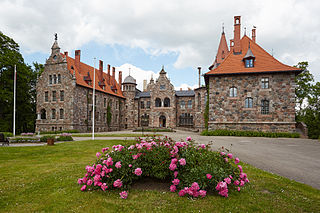
Cesvaine Palace is located in the town of Cesvaine, Latvia in Madona Municipality. Next to the palace lies remains of the old bishop's castle.

Lūznava Manor is a manor house located in the village of Lūznava, Rēzekne Municipality, Latvia. Today the local primary school of Lūznava is located in the manor house. There is also a 19th-century barn near the manor house.
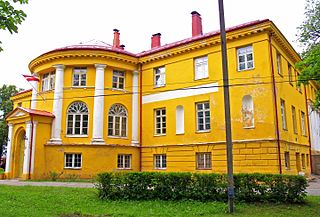
Tiņģere Manor is a manor house in Īve parish in Talsi municipality in the historical region of Courland, in western Latvia.

Ezere Manor, also called Lielezere Manor, is a manor house in the historical region of Courland, in western Latvia near the border with Lithuania. Ezere Manor house, constructed in 18th-19th centuries, is an architectural monument of national importance.

Reņģe Manor, also called Ruba Manor, is a manor house for the von Nolcken family that was built between 1881 and 1882 in the historical region of Zemgale, in Latvia. It is located about 2.5 km west of both the village of Ruba and the railroad bridge where the Glūda–Reņģe Railway crosses the Vadakste river along the border of Latvia and Lithuania. Manor building currently houses the Ruba Elementary School.

Vecmēmele Manor is a manor house in Mazzalve Parish, Nereta Municipality in the historical region of Selonia, in Latvia.

Gaujiena Castle is a castle in the historical region of Vidzeme, in northern Latvia. It was built between 1236 and 1238. Severely damaged in 1702 during the Great Northern War, the structure was abandoned.
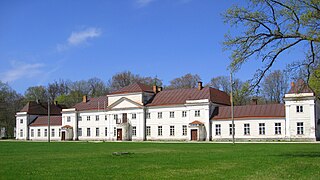
Varakļāni Palace is a palace in Varakļāni, Varakļāni Municipality in the historical region of Latgale, in Latvia.

Alatskivi Castle is a Neo-Gothic castle in Alatskivi, Estonia. Dating to the 17th century, it is situated in Peipsiääre Parish, Tartu County. It was rebuilt in the late 19th century by Baron Arved von Nolcken, modeled on the royal residence of Balmoral in Scotland. A renovation occurred between 2005 and 2011. Five rooms on the first floor house the Eduard Tubin museum, which documents his accomplishments as a music composer and conductor.
This page is based on this
Wikipedia article Text is available under the
CC BY-SA 4.0 license; additional terms may apply.
Images, videos and audio are available under their respective licenses.






